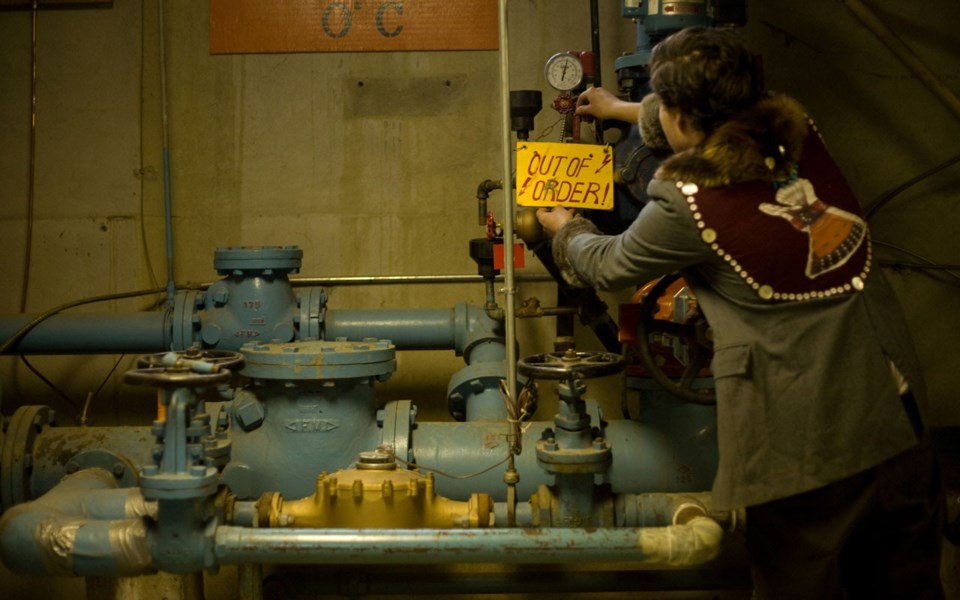Back in the late '50s, an English-born man named Oliver Jackson operated a museum in Kelowna, B.C. seemingly filled with First Nations' art.
His collection boasted around 4,000 items—from beadwork to masks to moccasins and instruments. The only problem: he was European.
When he passed away, his family approached the Kelowna Museum to see if they wanted the robust collection. They didn't have the capacity—and felt uncertain about showcasing what were essentially faux Indigenous artifacts. Instead, they approached the Sncewips Heritage Museum in the Westbank First Nation. "They wanted these works," says Curtis Collins, director and head curator at the Audain Art Museum. "The younger staff said, 'I don't know' (because of) ideas around appropriation and exploitation. However, when they started talking to the elders in those communities, they said, 'We respect this man' because at the time when it was illegal for First Nations people to carve and bead because of the government ban, Oliver Jackson showed them how to reconnect with some of these traditions."
Many of those items sat on tables sprawled in one of the inner rooms of the Audain Art Museum on Tuesday evening, just three days before the opening of Tales of An Empty Cabin: Somebody Nobody Was.
By the show's opening on Friday, Feb. 15, they would be positioned inside a wall tent, which lay collapsed on the floor, just one piece of a large exhibit featuring the work of Kaska Dena Nation artist Joseph Tisiga.
"The work is Oliver Jackson's but the conversation I'm interested in having is really with the First Nation and this gesture of resiliency and self-determination by controlling the dialogue," Tisiga says during a break from finishing that section of the exhibit. "I'm trying to introduce these objects and this collection of work as hopefully something that we can reflect on and have a conversation with. Whether I'm successful with what I'm aiming for ... I'm sort of OK with not hitting the mark, if that's the case. But you've got to start somewhere."
Tisiga, who was born in Edmonton, but now calls Whitehorse home, is just 34 and over a decade into his artistic career. (He also has a day job in social work there.) He's best known for his oil and watercolour paintings and collages, but got his start in assemblage, which he's returned to for this exhibit.
His work can be found in the National Gallery of Canada, the Montreal Museum of Fine Arts, as well as in private collections across the country. Most recently Tisiga was named a REVEAL Indigenous Art Award Winner.
He's garnered national acclaim for digging into themes of identity—sometimes in a satirical way.
"Normally, museums will not do an exhibition of a young artist," Collins says. "He's 34; he's only been practicing for about a decade. It's totally unusual ... I'm hoping it pushes him to the next level. We give him a big opportunity setting him up with the means, material, time, people to really push his practice."
The show also marks Collins' curatorial debut at the museum. When he started the job in May 2018, he quickly noticed a hole in the programming for February 2019.
While he had known Tisiga back when he ran the Yukon School of Visual Arts—inviting him to the school as a guest artist—it wasn't until Collins was out for lunch with a former VP from Sotheby's Auction House that an idea clicked.
"He mentioned Joseph and showed the work on his phone that he had bought for his personal collection and I went, 'That's it!'" Collins recalls.
For his part, Tisiga was intrigued, but nervous when he got the invitation. "It's a big show, it's a big space," he says. "I thought it was a really good opportunity to just try something and take the challenge, in a way ... He was just really open to whatever I was interested in doing."
Aside from the space dedicated to Oliver Jackson's complicated work—which will also include assemblage Tisiga was finishing with an astroturf canvas and items like constructed cigarette butts, golf balls and a fire pit—the show also includes large-scale, hand-tinted photographs from his No Home in Scorched Earth series in which he poses as the subject; the more traditional paintings and collages for which he is known borrowed from collections across Canada; and pieces from a series called A Prop for Reconciliation, which includes characters from Archie comics interacting with stereotypical Indigenous images.
"They're the stereotype of Euro-North America," Collins says of the comic book characters. "Archie rips off stories from everybody and kind of homogenizes them in a very particular Archie way, but in this context ... it's that interaction and discussion that Joseph wants to have about stereotypes about oppression, the relationships between Euro-North Americans, if you will, and First Nations."
The exhibit, however, will open with a reference to its namesake character and story. A series of performance photographs glean inspiration from a 1937 book by Archie Belaney, another European man who assumed a First Nations identity he called Grey Owl. "What Grey Owl was doing was acting out what people want to see an Indian person as," Collins says. "When I say 'people wanted to see' I mean people of European ancestry in Canada."
For his part, Tisiga says the goal is to explore his Kaska Dena identity—with the additional challenge that his people were historically nomadic and, therefore, focused on oral traditions rather than visual objects.
"When I think about making culturally oriented objects that have some authenticity or some naturalized history to them—I don't have that," he says. "So I have to look into fictions or self-generate iconography or cherry pick from things. In my paintings in the gallery you can see that."
Tales of an Empty Cabin: Somebody Nobody Was runs at the Audain Art Museum from February 16 until May 6.




